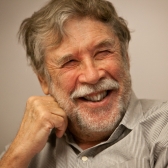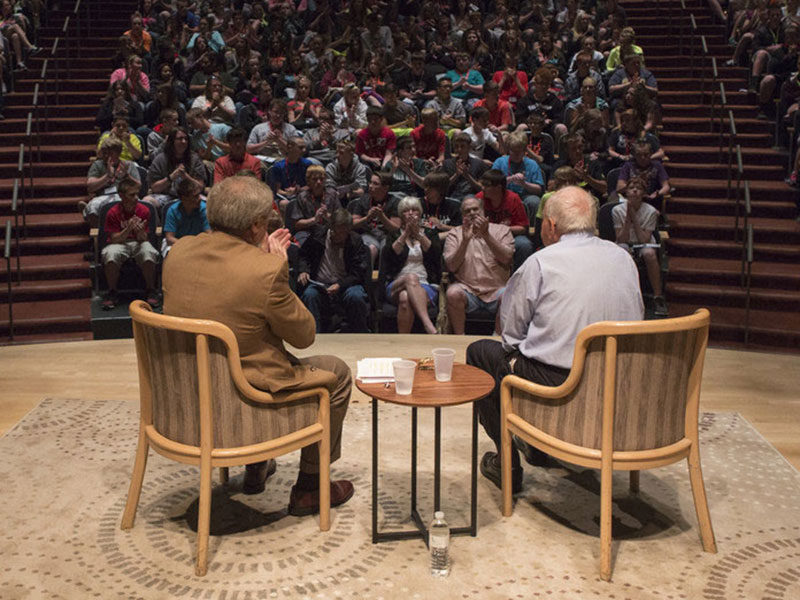May 13, 2009
Gideon discusses the time he spent hiding with a Catholic Slovak family. After his mother and sister perished in a German attack at Banska Bystrica, Gideon was rescued by the Slovak partisans and placed with the Strycharszyk family, who went to great lengths to hide and protect him.
LISTEN
Esta página también está disponible en español.
TRANSCRIPT
GIDEON FRIEDER:
Think about the intelligence of these people. I was possibly the first Jew they have seen in their life, but they understood what’s important to survive, how children survive.
NARRATOR
Over 60y years after the Holocaust, hatred, antisemitism, and genocide still threaten our world. The life stories of Holocaust survivors transcend the decades and remind us of the constant need to be vigilant citizens and to stop injustice, prejudice, and hatred wherever and whenever they occur.
This podcast series presents excerpts of interviews with Holocaust survivors from the United States Holocaust Memorial Museum’s public program First Person: Conversations with Holocaust Survivors.
In today’s episode Gideon Frieder talks with host Bill Benson about being hidden by a Catholic Slovak family after his mother and sister perished in a German attack at Banska Bystrica.
GIDEON FRIEDER:
The partisans, Henry, never realized I was wounded. But he realized that a child cannot survive in the mountains. The partisans were moving all the time, they were a fighting unit. Being saddled with a seven-year-old child is not something a fighting unit want to do, so they brought me to this village. At night.
And they selected the first house. They didn’t dare to go into the village. They surveyed the village for a long time, there was no movement. The village was so small, that there was no German garrison there. It’s a dirt road with some houses on the side. The word
BILL BENSON:
So it wasn’t like a safe house that they knew? It was just the first house they got to, and said, “Take this boy.”
GIDEON FRIEDER:
Yes. And there are two versions of it, in a sense. Henry, in his memoirs, which I used, which I was instrumental in publishing, I did all the computer work and set up to publish and so on, wrote that he came there, and these partisans were reasonably fearsome-looking, you know. They were not shaven really. They had all these grenades hanging on them. They have some machine guns taken from the Germans. And told them to keep this child safe, and if not, they will come next night and kill all of you. Which is kind of a persuasive argument I would say. That is his story.
My father’s story was that they were promised a nice reward. Everybody knew that the war is over and it’s just a matter of time. And they were told that I’m a son of a very important man and that if I survived they would be rewarded. I don’t know. I assume that both stories are correct. There was a carrot and stick approach by the partisans.
I have to say that while I was there, everything they did was not a product of fear. I felt wanted. I felt, within certain limits, while I was in the house, safe. I never left more than fifty meters perimeter from the house. So all my stay there I never left the vicinity of the house. So I wouldn’t say that I was very assured about my safety. But . . .
BILL BENSON:
And you were there for quite a while.
GIDEON FRIEDER:
I was there from October ’44 till April ’45. I never left the vicinity of the house. Except once, when in December we walked to the real village next to it. I would assess it’s about five kilometers, three and a half miles, three miles, three and a half miles. We walked there for the midnight mass in Christmas, in December, through the snow. But I don’t remember any other time that I left the vicinity of the house.
BILL BENSON:
And speaking of going to the mass, the family gave you an identity.
GIDEON FRIEDER:
Oh, yes. Obviously when I came. One of the reasons I believe they did everything . . . Let me step back. That village of possibly 50 houses, if that much, maybe 25, saved ten families of Jews.
BILL BENSON:
In that one village?
GIDEON FRIEDER:
That one little village of extremely religious Catholics, in the hut I was in, in this house. By the way, the picture of the house is a modern picture. At the time there was not the concrete side of the house was not there. And there were no real glass windows beautifully painted white. This is a new picture.
Every wall in these two big rooms which the house consisted of, had a large picture of the heart of Jesus. These are very deeply believing Catholics. They saved many people. So when I came there, it was very obvious that if I were called Gideon Frieder, my chances of survival are rather minimal. So they gave me a Slovak name, a very Slovak-sounding name. I was called Jan Suchý. So Jan is the Slavic version of John. And the endearment is Janko, so they called me Janko. Suchý is a very typical, Slovak-sounding name. It’s very funny in a sense because suchý means in Slovak “dry.” And when I was brought there I was anything but dry. I was dripping wet. I was a mess.
And they taught me . . . first of all they established another identity. I was the son of the brother of the woman. And the brother of the woman, look how clever – these were totally uneducated people. They were so intelligent. You do know that intelligence and education are two different things. They were so intelligent; they understood what has to be done. They understood that they have to establish an identity for me, which will be impeccable. My pedigree should be impeccable. So my pedigree was: I was the son of the brother of the woman, and the brother was killed by the partisans. So for the Germans I was really somebody of value. I mean, obviously I don’t like the partisans; my father was killed by them.
And they taught me. They taught me a sentence. They said if somebody will ask you this, you tell them that. And for the life of me I couldn’t understand what they taught me. I couldn’t care less. I memorized it and I used it.
I discovered only later on. What they taught me was the Lord’s Prayer. Sorry. Obviously, no Jewish boy will know the Lord’s Prayer. But you have to go back to the 1940s. These were Catholics. The Catholic Church used the Latin mass. All the liturgy was in Latin, with three exceptions, which were always in the language of the country. And one of the exceptions was the Lord’s Prayer.
But these were not essentially university graduates; they were not even graduates of a primary school. They were taught this by their parents, which were taught by their parents over generations. The words in Slovak will be: otec náš ktorý si na nebesiach; “Our Father in heaven . . . .” This [is] called Otčenáš; “Our Father.” All the words were slurred to each other. But this is the way the Slovaks knew it anyway right? It doesn’t matter that you slurred it on because on the kids would slur it on. They didn’t understand the Latin mass, they didn’t understand what they are saying here either until they became older and they could parse the sentence. So this established my identity as a good Catholic boy by the name of Jan Suchý.
So I passed. But think about the intelligence of these people. The understanding they have. What it takes to survive. I was possibly the first Jew they have seen in their life, but they understood what’s important to survive, how children survive, and they did everything to survive. I’ve many proofs, which happened many years later, that what they did they didn’t do because they were threatened.
NARRATOR:
You have been listening to First Person: Conversations with Holocaust Survivors, a podcast series of the United States Holocaust Memorial Museum. Every Wednesday at 1 p.m. from March through August, Holocaust survivors share their stories during First Person programs held at the Museum in Washington, DC. We would appreciate your feedback on this series. [Please take our First Person podcast survey (external link) and let us know what you think.]
[On] our website you can also learn more about the Museum’s survivors, listen to the complete recordings of their conversations, and listen to the Museum podcasts Voices on Antisemitism and Voices on Genocide Prevention.


